The Duquesne Spy Ring
the largest espionage case in United States history that ended in convictions, a total of 33 members of a German espionage network

led by Fritz Joubert Duquesne
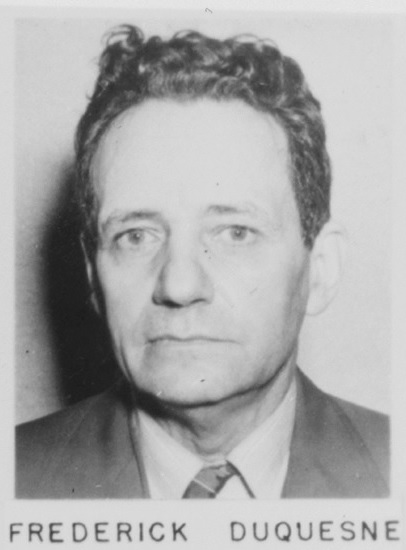
Fritz Joubert Duquesne was a Captain in the Second Boer War and later a Colonel in the Abwehr, Germany’s division of military intelligence.
Duquesne was captured and imprisoned three times by the British, once by the Portuguese, and once by the Americans in 1917, and each time he escaped.

In World War I, he was a spy and ring leader for Germany and during this time he sabotaged British merchant ships in South America with concealed bombs and destroyed several.

Duquesne was also ordered to assassinate an American, Frederick Russell Burnham, Chief of Scouts for the British Army, but failed to do so.

He was also one of the founders of the Boy Scouts of America , along with Theodore Roosevelt and Robert Baden-Powell.
Duquesne was also known as “The man who killed Kitchener“ since he claimed to have sabotaged and sunk HMS Hampshire, on which Lord Kitchener was en route to Russia in 1916.

In the spring of 1934, Duquesne became an intelligence officer for the Order of 76, an American pro-Nazi organization, and in January 1935 he began working for U.S. government’s Works Progress Administration.

Admiral Wilhelm Canaris, head of the Abwehr, knew Duquesne from his work in World War I and he instructed his new chief of operations in the U.S., Col. Nikolaus Ritter, to make contact.

Ritter had been friends with Duquesne back in 1931 and the two spies reconnected in New York on December 3, 1937.
On February 8, 1940, Ritter sent Sebold, under the alias of Harry Sawyer, to New York and instructed him to set up a shortwave radio-transmitting station and to contact Duquesne, code-named DUNN, then operating a business known as the Air Terminals Company in New York City.

After establishing his first contact with Duquesne by letter, Sebold met with him in Duquesne’s office.
During their initial meeting, Duquesne, who was extremely concerned about the possibility of electronic surveillance devices being present in his office, gave Sebold a note stating that they should talk elsewhere.
After relocating to an Automat, the two men exchanged information about members of the German espionage system with whom they had been in contact.

Once the FBI discovered ,through Selbold that Duquesne,were again in New York operating as a German spies, director J. Edgar Hoover provided a background briefing to President Franklin Roosevelt.

FBI agent Raymond Newkirk, using the name Ray McManus, was now assigned to DUNN and he rented a room immediately above Duquesne’s apartment near Central Park and used a hidden microphone to record Duquesne’s conversations.

But monitoring Duquesne’s activities proved to be difficult.

As Newkirk described it, “The Duke had been a spy all of his life and automatically used all of the tricks in the book to avoid anyone following him … He would take a local train, change to an express, change back to a local, go through a revolving door and keep going on right around, take an elevator up a floor, get off, walk back to the ground, and take off in a different entrance of the building.”

Duquesne also informed Sebold that he was certain he was under surveillance, and he even confronted one FBI agent and demanded that he stop tracking him, a story confirmed by agent Newkirk.

Duquesne provided Sebold with information for transmittal to Germany during subsequent meetings, and the meetings which occurred in Sebold’s office were filmed by FBI Agents.

Duquesne, who was vehemently anti-British, submitted information dealing with national defense in America, the sailing of ships to British ports, and technology.

He also regularly received money from Germany in payment for his services.

On one occasion, Duquesne provided Sebold with photographs and specifications of a new type of bomb being produced in the United States.

He claimed that he secured that material by secretly entering the DuPont plant in Wilmington, Delaware.
Duquesne also explained how fires could be started in industrial plants.
Much of the information Duquesne obtained was the result of his correspondence with industrial concerns.
Representing himself as a student, he requested data concerning their products and manufacturing conditions.
In a letter to the Chemical Warfare Service in Washington, D.C., Duquesne requested information on a new gas mask.
He identified himself as a “well-known, responsible and reputable writer and lecturer”.
At the bottom of the letter, he wrote, “Don’t be concerned if this information is confidential, because it will be in the hands of a good, patriotic citizen.”
A short time later, the information he requested arrived in the mail, a week later it was being read by intelligence officers in Berlin.

Duquesne was brought to trial and was convicted.
He was sentenced to serve 18yr in prison on espionage charges, as well as a 2yr concurrent sentence and payment of a $2,000 fine for violation of the Foreign Agents Registration Act.
He served his sentence in Leavenworth Federal Penitentiary in Kansas, where he was mistreated and beaten by other inmates.

In 1954 he was released due to ill health, having served 14 years, and died indigent, at City Hospital on Welfare Island (now Roosevelt Island), New York City on May 24, 1956, at the age of 78.
Paul Bante

- Native German
- served in the German Army during WW I.
- came to the United States in 1930
- naturalized U.S. citizen in 1938.
- Formerly a member of the German-American Fund,
- claimed that Germany put him in contact with one of their operatives, Paul Fehse, because of Bante’s association with a Dr. I.T. Griebl.

Bante claimed as a member of the Gestapo, his function was to create discontent among union workers, stating that every strike would assist Germany.
Sebold met Bante at the Little Casino Restaurant, which was frequented by several members of this spy ring.
During one such meeting, Bante advised, he was preparing a bomb fuse, and subsequently delivered dynamite and detonation caps to Sebold.
Entering a guilty plea to violation of the Foreign Agents Registration Act, Bante was sentenced to 18m imprisonment and was fined $1,000.
Max Blank

- came to the United States from Germany in 1928.
- never became a U.S. citizen
- employed in New York City at a German library and at a book store which catered to German trade.
Paul Fehse, a major figure in this case, informed Germany, Blank, who was acquainted with several members of the spy ring, could secure valuable information, but lacked the funds to do so.

They told Sebold, Blank could obtain details about rubberized self-sealing airplane gasoline tanks, as well as a new braking device for airplanes, from a friend who worked in a shipyard.

However, he needed money to get the information.
Blank boasted to agent Sebold,he had been in the espionage business since 1936, but lost interest in recent years, because payments from Germany had fallen off.
Blank pleaded guilty to violation of the Foreign Agents Registration Act. He received a sentence of 18m imprisonment and a $1,000 fine.
Alfred E. Brokhoff

- native of Germany, Alfred E. Brokhoff,
- came to the United States in 1923
- naturalized citizen in 1929.
- Mechanic for the United States Lines in New York City for 17 years prior to his arrest.
Because of his employment on the docks, he knew almost all of the agents, in this group, who were working as seamen on various ships.
Brokhoff helped Fehse secure information about the sailing dates and cargoes of vessels destined for England.

He also assisted Fehse in transmitting information to Germany.
German agent, George V. Leo Waalen, reported that he had received information from Brokhoff, for transmittal to Germany.
Upon conviction, Brokhoff was sentenced to serve a 5yr prison term for violation of the espionage statutes and to serve a 2yr concurrent sentence for violation of the Registration Act.
Heinrich Clausing

- German-born
- naturalized citizen in 1938
- served on various ships sailing from New York Harbor was employed as a cook on the SS Argentine at time of arrest.
Closely associated with Franz Stigler, one principal contact man, for this spy ring, Clausing operated as a courier.
He transported micro photographs and other material from the US to South American ports, which was sent to Germany via Italian airlines.
He also established a mail drop, in South America for expeditious transmittal of information to Germany .
He signed his letters as “Carlos“and received no money but had spied to help Germany.
Clausing was convicted and was sentenced to serve 8yrs for violation of espionage statutes. He also received a 2 yr concurrent sentence for violation of the Registration Act.
Conradin Otto Dold

- came to United States in 1926.
- U.S. citizen in 1934 under the Seamen’s Act.
- Chief Steward aboard the SS Siboney of the American Export Lines.
Dold was related to people holding high positions in Germany and was closely associated with other members of the espionage group, who worked on ships sailing from New York Harbor.

As a courier, Dold carried information from Nazi agents in the United States to contacts in neutral ports abroad for transmittal to Germany.
Dold was sentenced to a 10 yr in prison on espionage charges and received a 2yrs concurrent sentence and a fine of $1,000 for violation of the Registration Act.

Rudolf Ebeling

- came to the United States in 1925
- employed as a foreman in the Shipping Department of Harper and Brothers in New York City .
- obtained information regarding ship sailings and cargoes, which he provided to Paul Fehse for transmittal to Germany.
- furnished information to Leo Waalen, who delivered the material to Sebold for transmittal.
Upon conviction, Ebeling was sentenced to 5 yrs in prison on espionage charges. He also received a 2 yr concurrent sentence and a $1,000 fine for violating the Registration Act.

Richard Eichenlaub

- came to the United States in 1930
- became a citizen in 1936
- operated the Little Casino Restaurant in the Yorkville Section of New York City.
The restaurant was a rendezvous for many members of this spy ring, Eichenlaub introduced several new members into the group.

Eichenlaub, reported to Gestapo and often obtained information from his customers who were engaged in national defense production.
Through Eichenlaub, dynamite was delivered to Sebold from Bante.
Having entered a plea of guilty to violation of the Registration Act, Eichenlaub was sentenced to pay a fine of $1,000 and to serve 18 months in prison.
Heinrich Carl Eilers

- native of Germany
- cameto the United States in 1923
- became a citizen in 1932. From 1933
- served as a steward on ships sailing from New York City
Eilers made a trip from New York to Washington, D.C., to obtain information for Germany from the Civil Aeronautics Authority.
His mission, however, was unsuccessful.
At the time of his arrest in 1940 in New York City by Customs authorities, he had in his possession 20 letters addressed to people throughout Europe.

He also had books relating to magnesium and aluminum alloys, which were sent to him by Edmund Carl Heine, one of the principal espionage agents in this group.
Upon conviction, Eilers received a 5 yr prison sentence on espionage charges and a concurrent sentence of 2 yrs imprisonment and a $1,000 fine under the Registration Act.
Paul Fehse

- came from Germany to the United States, 1934
- became a citizen in 1938 Since his arrival in the United States, employed as a cook aboard ships sailing from New York Harbor.
Fehse was one of the directing forces in this espionage group.
He arranged meetings, directed members’ activities, correlated developed information for its transmittal to Germany, chiefly through Sebold.
Fehse, who was trained for espionage work in Hamburg, Germany, claimed he headed the Marine Division of the German espionage system in the United States.
Having become nervous, Fehse made plans to leave the country.
He obtained a position on the SS Siboney, which was scheduled to sail from Hoboken, New Jersey, for Lisbon, Portugal, on March 29, 1941.

He planned to desert ship in Lisbon and return to Germany.
However, before he could leave the United States, Fehse was arrested by FBI Agents.
Upon arrest, he admitted sending letters to Italy for transmittal to Germany, as well as reporting movements of British ships.
On April 1, 1941, Fehse was sentenced, on a plea of guilty ,to serve 1 yr and 1 day in prison for violation of the Registration Act.
He subsequently pleaded guilty to espionage and received a prison sentence of 15 years.
Edmund Carl Heine

- native of Germany
- came to the United States in 1914
- naturalized citizen in 1920.
- U held various positions in the foreign sales and service department of Ford Motor Companyand Chrysler Corporation.
His employment took him to the West Indies, South America, Spain, and Berlin, Germany.
Heine was closely associated with Dr. Hans Luther, former German Ambassador in Washington, D.C., and Prince Louis Ferdinand of Berlin.
Around 1938, Heine was recruited to find American automobile and aviation industry secrets ,which could be passed to Germany through the Duquesne Spy Ring.

Heine sent letters from Detroit, Michigan, to Lilly Stein, a German spy, Sebold was instructed to contact.
The letters contained detailed technical data regarding the military, aircraft construction, and various industries.

He also wrote aircraft companies, to obtain information about their production, number of employees, and the time required to construct military planes.
Later it was discovered ,Heine was also the mysterious “Heinrich” ,who supplied the spy ring with aerial photographs.
After obtaining technical books relating to magnesium and aluminum alloys, Heine sent the materials to Heinrich Eilers.

To ensure safe delivery of the books to Germany, in case they did not reach Eilers, Heine indicated the return address on the package, as the address of Lilly Stein.
Upon conviction of violating the Registration Act, Heine received a $5,000 fine and a 2 r prison sentence.
Felix Jahnke

- left Germany for the United States in 1924
- naturalized citizen in 1930
- attended military school in Germany
- served in the German Army as a radio operator.
Jahnke and Axel Wheeler-Hill, secured the services of Josef Klein, a radio technician, to build a portable radio set,for Jahnke’s apartment in the Bronx.
Jahnke used this radio to transmit messages, which were intercepted by the FBI, to Germany.

He also visited New York Harbor, to obtain information about any vessels bound for England.
After pleading guilty to violation of the Registration Act, Jahnke was sentenced to serve 20 months in prison and to pay a $1,000 fine.
Gustav Wilhelm Kaercher

- came to the United States in 1923,
- became a citizen in 1931
- served in the German Army during World War I former leader of the German Bund in New York
During visits to Germany, he was seen to have worn a German Army officer’s uniform.
At the time of his arrest, he was engaged in designing power plants for the American Gas and Electric Company in New York City.

Kaercher was arrested with Paul Scholtz, who just handed Kaercher a table of call letters and frequencies for transmitting information to Germany by radio.
As a result, his guilty plea to charges of violating the Registration Act, Kaercher received a $2,000 fine and a prison sentence of 22 months.
Josef Klein

- native of Germany, Josef Klein
- came to the United States in 1925
- did not become a citizen
- a photographer and lithographer
- interested in the building and operation of shortwave radio transmitters
Klein constructed a portable shortwave radio transmitting-and-receiving set for Felix Jahnke and Axel Wheeler-Hill.
When he built the radio set, Klein knew it would be used for transmitting messages to Germany.
Upon conviction, Klein received a sentence of 5 years imprisonment on espionage charges and a concurrent sentence of 2 yrs imprisonment under the Registration Act.
Hartwig Richard Kleiss

- came to the United States in 1925
- naturalized citizen 6years later
- employed as a cook on various ships
Kleiss obtained information for Germany, including blueprints of the SS America which showed the locations of newly installed gun emplacements.
He included information about how guns would be brought into position for firing and obtained details on the construction and performance of new speedboats, being developed by the United States Navy, which he submitted to Sebold for transmittal to Germany.

Kleiss originally chose to stand trial, However, after cross-examination, he changed his plea to guilty on the charge of espionage and received an 8 yr prison sentence.
Herman W. Lang

- participated with Adolf Hitler in the Munich beer hall putsch of 1923
- came to the United States from Germany in 1927
- became a citizen in 1939
He was one of the four people Sebold had been told to contact in the United States.
Until his arrest, Lang had been employed by the Carl L. Norden Corp., which manufactured the top secret Norden bombsite and other highly confidential materials, essential to the national defense of the United States.

During a visit to Germany in 1938, Lang conferred with German military authorities, Colonel Nikolaus Ritter of the Abwehr, and reconstructed the plans of the confidential materials from memory.
Ritter hid the plans in the wooden casing for an umbrella and on January 9, 1938, personally handed the umbrella off to a German steward and secret courier on the ship Reliance bound for Bremen.
The Norden bombsite had been considered, a critical wartime instrument by the United States Army Air Forces, and American bombardiers were required to take an oath during their training stating that they would defend its secret with their own life, if needed.
It is perhaps because of Lang, that bombsite instruments used by Luftwaffe bombers during the war were fairly similar to the United States’ Norden bombsite.
The Lotfernrohr 3 and the BZG 2 in 1942, used a similar set of gyroscopes which provided a stabilized platform for the bombardier to sight through, although the more complex interaction between the bombsite and autopilot was not used.

Later in the war, Luftwaffe bombers used the Lotfe 7, which had an advanced mechanical system, similar to the Norden bombsite, but was much simpler to operate and maintain.
At one point, Sebold was ordered to contact Lang, as it became known, the technology he stole from Norden, was being used in German bombers.
The Nazis offered to spirit him to safety in Germany, but Lang refused to leave his home in Ridgewood, Queens.
Upon conviction, Lang received a sentence of 18 yr in prison on espionage charges and a 2 yr concurrent sentence under the Registration Act.
Lang was deported to Germany, in September 1950.
Evelyn Clayton Lewis

- native of Arkansas
- had been living with Duquesne in New York City
- had expressed her anti-British and anti-Semitic feelings during her relationship with Duquesne
- was aware of his espionage activities and condoned them
While she was not active in obtaining information for Germany, she helped Duquesne prepare material for transmittal abroad.
Upon a guilty plea, Lewis was sentenced to serve 1 yr and 1 day in prison for violation of the Registration Act.
Rene Emanuel Mezenen
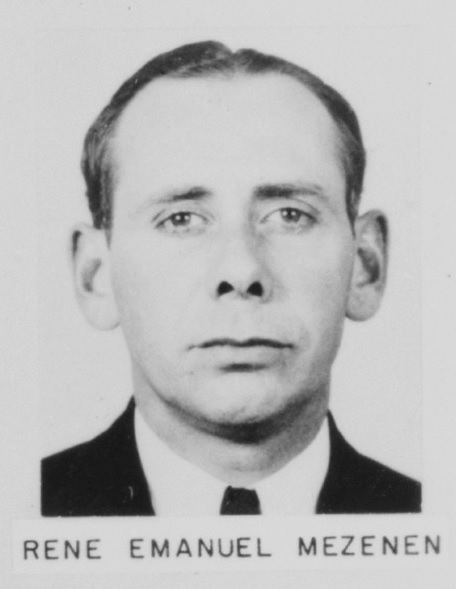
- a Frenchman
- claimed U.S. citizenship through the naturalization of his father.
- employed as a steward in the Pan American transatlantic clipper service.
- German Intelligence Service in Lisbon, Portugal, asked Mezenen to act as a courier
- transmitted information between the US and Portugal on his regular commercial aircraft trips
As a steward, he was able to deliver documents from New York to Lisbon in 24 hrs.
He accepted this offer for financial gain.
In the course of flights across the Atlantic, Mezenen reported his observance of convoys sailing for England.
He also became involved in smuggling platinum, from the United States to Portugal.
When discussing his courier role, Mezenen boasted that he hid the spy letters so well, if they were found it would take two to three weeks to repair the airplane.
Following a plea of guilty, Mezenen received an 8 yr prison term for espionage and 2 concurrent years for registration violations.
Carl Reuper
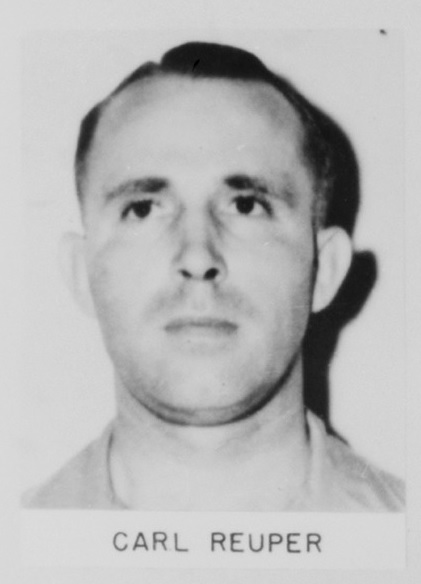
- came to the United Statesin 1929
- became a citizen in 1936
- served as an inspector for the Westinghouse Electric Company in Newark, New Jersey
- Previously, worked as a mechanic for the Air Associates Company in Bendix, New Jersey
Reuper obtained photographs for Germany, relating to national defense materials and construction, which he obtained from his employment.
He arranged radio contact with Germany through the station established by Felix Jahnke.
On one occasion, he conferred with Sebold, regarding the latter’s facilities for communicating with German authorities.
Upon conviction, Reuper was sentenced to 16 yrs imprisonment on espionage charges and 2 yrs concurrent sentence under the Registration Act.
Everett Minster Roeder

- Born in the Bronx, New York
- son of a celebrated piano instructor, Carl Roeder
- child prodigy
- was 15 yrs old he enrolled in engineering at Cornell University and there he met the brothers Edward and Elmer Sperry
- dropped out of school when he was 18 and married his pregnant girlfriend.
He was one of the first employees at the Sperry Gyroscope Company, where he worked as an engineer and designer of confidential materials for the U.S. Army and Navy.
At is job as a gyroscope expert working on U.S. military contracts, Roeder built machines such as tracking devices for long range guns capable of hitting moving targets 10 miles away, aircraft autopilot and blind-flying systems, ship stabilizers, and anti-aircraft search lights.
Sebold delivered micro photograph instructions to Roeder, as ordered by German authorities.
Roeder and Sebold met in public places and proceeded to spots where they could talk privately.
In 1936, Roeder had visited Germany and was requested by German authorities, to act as an espionage agent.
Primarily due to monetary rewards he would receive, Roeder, agreed.
Among the Sperry development secrets, Roeder disclosed, were the blueprints of the complete radio instrumentation of the new Glenn Martin bomber, classified drawings of range finders, blind-flying instruments, a bank-and-turn indicator, a navigator compass, a wiring diagram of the Lockheed Hudson bomber, and diagrams of the Hudson gun mountings.
From Roeder, Abwehr also obtained plans for an advanced automatic pilot device, that was later used in Luftwaffe fighters and bombers.*
At the time of his arrest, Roeder had 16 guns in his Long Island home.
Roeder entered a guilty plea to the charge of espionage, and was sentenced to 16 yr in prison.
In 1949, Roeder published his book, Formulas in plane triangles.
Paul Alfred W. Scholz
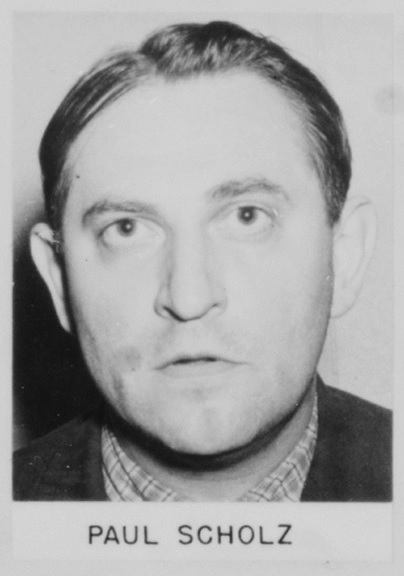
- German native
- came to the United States in 1926
- never attained citizenship
- employed in German book stores in New York City
- disseminated Nazi propaganda
- arranged for Josef Klein, to construct the radio set used by Felix Jahnke and Axel Wheeler-Hill
At the time of his arrest, Scholz just gave Gustav Wilhelm Kaercher, a list of radio call letters and frequencies.
He also encouraged members, of this spy ring, to secure data for Germany and arranged contacts between various German agents.
Upon conviction, Scholz was sentenced to 16 yr imprisonment for espionage with 2 yr concurrent sentence under the Registration Act.
George Gottlob Schuh
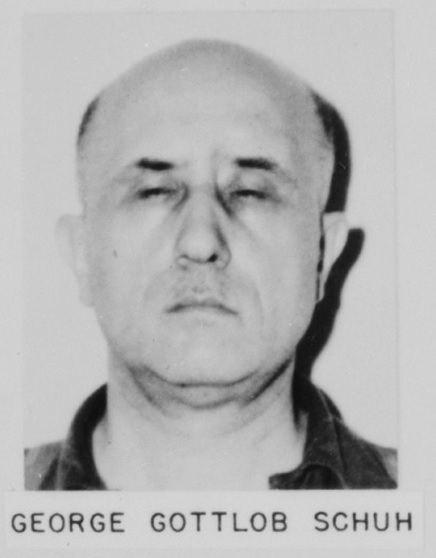
- native of Germany
- came to the United States in 1923
- became a citizen in 1939
- employed as a carpenter.
- German agent
- sent information to the Gestapo in Hamburg
- provided Alfred Brokhoff, information which said Winston Churchill arrived in the United States, on the HMSKing George V.
He also furnished information to Germany, concerning the movement of ships carrying materials and supplies to Britain.
Having plead guilty to violation of the Registration Act, Schuh received a sentence of 18 months in prison and a $1,000 fine.
Erwin Wilhelm Siegler
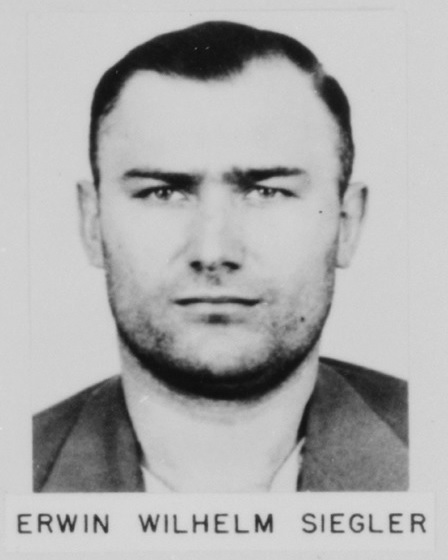
- came to the United States from Germany in 1929
- attained citizenship in 1936
- chief butcher on the SS America until it was taken over by the U.S. Navy
- As courier, Siegler brought micro photographic instructions to Sebold from German authorities on one occasion.
- brought $2,900 from German contacts, abroad to pay Lilly Stein, Duquesne, and Roeder, for their services and to buy a bombsite.
He served the espionage group, as an organizer and contact man.
He also obtained information about the movement of ships and military defense preparations at the Panama Canal.
Subsequent to his conviction, Siegler was sentenced to 10 years’ imprisonment on espionage charges and a concurrent 2-year term for violation of the Registration Act.
Oscar Richard Stabler
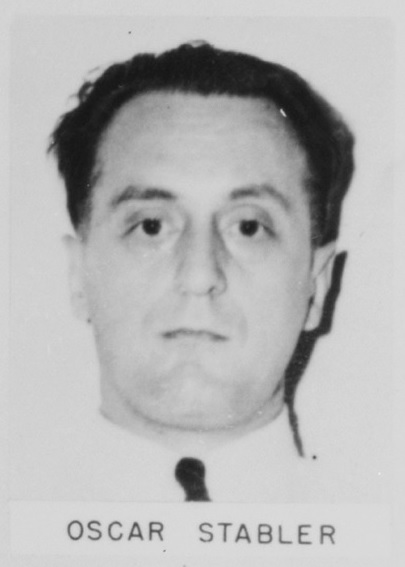
- Born in Germany
- came to the United States in 1923
- became a citizen in 1933
- employed primarily as a barber aboard transoceanic ships.
- In December 1940, British authorities in Bermuda found a map of Gibraltar, in his possession.
- detained for a short period before being released.
As a close associate of Conradin Otto Dold, Stabler served as a courier, transmitting information between German agents, in the United States and contacts abroad.
Stabler was convicted and sentenced to serve 5 yrs in prison for espionage and a 2 yr concurrent term under the Registration Act.
Heinrich Stade
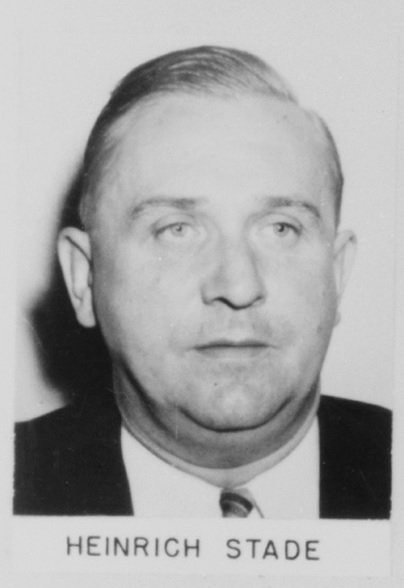
- came to the United States from Germany in 1922
- became a citizen in 1929
- musician and publicity agent in New York
- told agent Sebold he had been in the German Gestapo since 1936 and boasted that he knew everything in the spy business
- arranged for Paul Bante’s contact with Sebold, and had transmitted data to Germany regarding points of rendezvous for convoys carrying supplies to England.
Stade was arrested while playing in the orchestra, at an inn on Long Island, New York.
Following a guilty plea to violation of the Registration Act, Stade was fined $1,000 and received a 15-month prison sentence.
Lilly Barbara Carola Stein
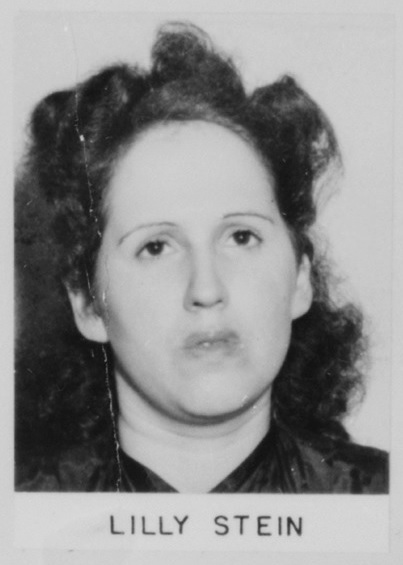
- Born in Vienna
- Jewish immigrant who had escaped in 1939 with the help of a U.S. diplomat in Vienna, Vice Consul Ogden Hammond Jr.
- met Hugo Sebold, the espionage instructor, who had trained William Sebold (the two men were not related) in Hamburg, Germany.
- She enrolled in the school, and was sent to the United States, by way of Sweden in 1939.
In New York, she worked as an artist’s model and was said to have moved in New York’s social circles.
As a German agent, her mission was to find her targets at New York nightclubs, sleep with these men, attempt to blackmail them, or otherwise entice them to give up valuable secrets.
One FBI agent described her as, a “good-looking nymphomaniac”.

Stein, was one of the people, to whom Sebold had been instructed to deliver micro photograph instructions, upon his arrival in the United States.
She frequently met with Sebold, to give him information for transmittal to Germany, and her address was used as a return address by other agents in mailing data for Germany.
Stein pleaded guilty and received sentences of, 10 yr and 2 concurrent yr imprisonment for violations of espionage ,and registration statutes, respectively.

She served 12 years. and left for France, where she found employment, at a luxury resort near Strasbourg.
Franz Joseph Stigler

- left Germany for the United States
- became a citizen in 1939He
- employed as a crew member and chief baker aboard U.S. ships
- until his discharge from the SS America when the U.S. Navy converted that ship into USS West Point.
His constant companion was Erwin Siegler, they operated as couriers in transmitting information between the United States and German agents aboard.

Stigler sought to recruit amateur radio operators, in the United States as channels of communication to German radio stations.

He also observed and reported defense preparations, in the Panama Canal Zone and met with other German agents, to advise them in espionage pursuits.
In January 1941, Stigler asked agent Sebold to radio Germany that Prime Minister Winston Churchill had arrived, secretly in the U.S. on the H.M.S. King George V with Lord Halifax.

Upon conviction, Stigler was sentenced to serve 16 years in prison on espionage charges with 2 concurrent years for registration violations.
Erich Strunck
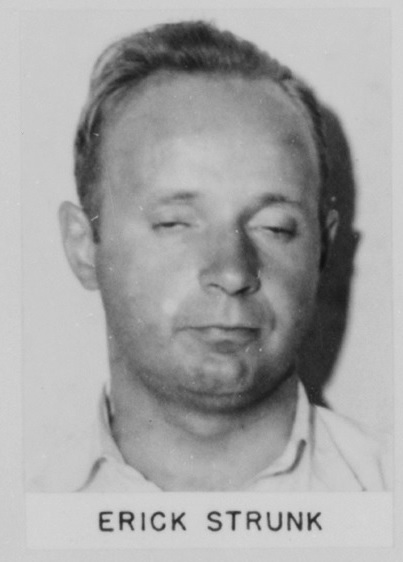
- seaman aboard the ships of the United States Lines
- went to the United States from Germany in 1927
- became a naturalized citizen in 1935. As a courier, carried messages between German agents in the United States and Europe
- requested authority to steal the diplomatic bag of a British officer traveling aboard his ship, and dispose of the officer by pushing him overboard.
- Sebold convinced him, it would be too risky
Strunck was convicted and sentenced to serve 10 years in prison on espionage charges – also sentenced to serve a 2 year concurrent term under the Registration Act.
Leo Waalen
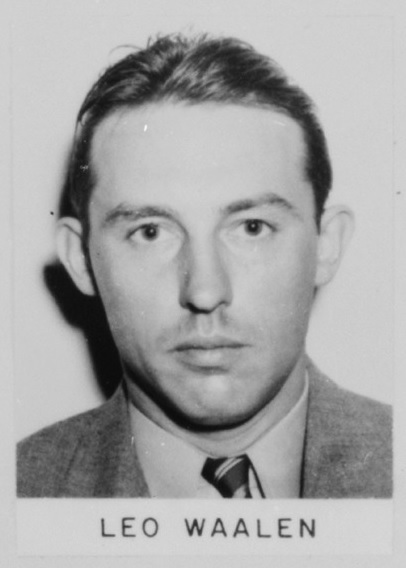
- born in Danzig, Germany
- entered the UStby “jumping ship” around 1935 painter for a small boat company, constructed small craft for the U.S. Navy
- gathered information about ships sailing for England.
- obtained a confidential booklet, issued by the FBI which contained precautions, taken by industrial plants, to safeguard national defense materials from sabotage.
He secured government contracts, listing specifications for materials and equipment, as well as detailed sea charts, of the United States Atlantic coastline.

In May 1941, the SS Robin Moor was carrying 9 officers, 29 crewmen, 7 or 8 passengers, and a commercial cargo from New York to Mozambique via South Africa, without a protective convoy.
On 21 May, the ship was stopped by U-69, in the tropical Atlantic ,750 miles west of the British-controlled port of Freetown, Sierra Leone.
Although the SS Robin Moor was flying the flag of a neutral country, her mate was told by the U-boat crew that they had decided to “let us have it.”
After a brief period, the ship’s crew and passengers, boarded, her four lifeboats, the U-boat fired a torpedo, and then shelled the vacated ship.

Once the ship sank beneath the waves, the submarine’s crew pulled up to Captain W.E. Myers’ lifeboat, left him with four tins of ersatz bread and two tins of butter, and explained that the ship had been sunk because she was carrying supplies to Germany’s enemy.
In October 1941, federal prosecutors adduced testimony that Waalen, one of the fourteen accused men, who had pleaded not guilty to all charges, submitted the sailing date of the SS Robin Moor, for radio transmission to Germany, five days before the ship began her final voyage.
Following his conviction, Waalen was sentenced to 12 years in prison for espionage and a concurrent 2-year term for violation of the Registration Act.
Adolf Henry August Walischewski
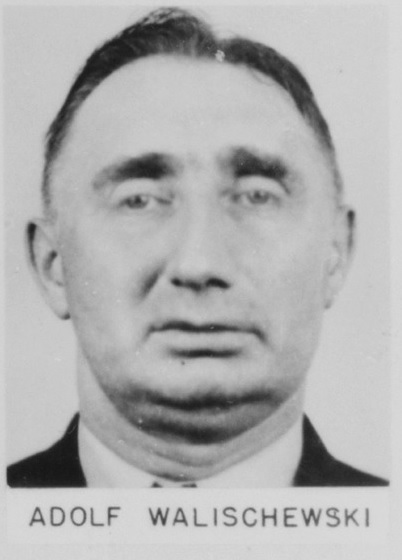
- German native
- was a seaman
- naturalized citizen in 1935
- connected with the German espionage system through Paul Fehse
- duties were confined to those of courier, carrying data from agents, in the United States to contacts abroad.
Upon conviction, Walischewski received a 5 year prison sentence on espionage charges, as well as a 2 year concurrent sentence under the Registration Act.
Else Weustenfeld
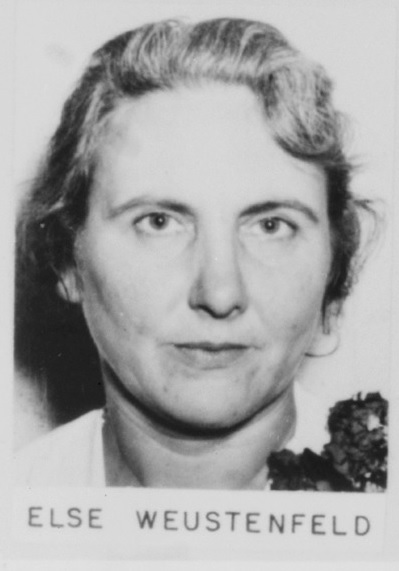
- arrived in the United States from Germany in 1927
- became a citizen 10 years later
- a secretary for a law firm representing the German Consulate in New York City
- was thoroughly acquainted with the German espionage system
- delivered funds to Duquesne, which she received from Lilly Stein, her close friend
She lived in New York City ,with Hans W. Ritter, a principal in the German espionage system.
His brother, Nickolaus Ritter, was the “Dr. Renken“, who enlisted Sebold, as a German agent.
In 1940, Weustenfeld visited Hans Ritter in Mexico, where he was serving as a paymaster for the German Intelligence Service.
After pleading guilty, Else Weustenfeld was sentenced to 5 years imprisonment, on charge of espionage and 2 concurrent years on a charge of registration violations.
Axel Wheeler-Hill

- came to the United States in 1923 from his native Russia
- naturalized as a citizen in 1929
- employed as a truck driver
- obtained information, for Germany regarding ships sailing to Britain from New York Harbor
With Felix Jahnke, he enlisted the aid of Paul Scholz, in building a radio set for sending coded messages to Germany.

Following conviction, Wheeler-Hill was sentenced to serve 15 years in prison for espionage and 2 concurrent years under the Registration Act.
Bertram Wolfgang Zenzinger

- Born in Germany
- came to the United States in 1940
- naturalized citizen of the Union of South Africa
- reported reason for coming to the United States was to study mechanical dentistry in Los Angeles, California
- July 1940, Zenzinger received a pencil for preparing invisible messages, for Germany, in the mail from Siegler.
He sent several letters to Germany through a mail drop in Sweden, outlining details of national defense materials on April 16, 1941.
Pleading guilty, he received 18 months in prison for violation of the Registration Act and 8 yrs imprisonment for espionage.